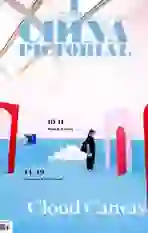Virtual Graduation Show
2020-08-10byAnneCao
by Anne Cao

The graduate show is the most import- ant graduation season event for art schools. This year, the coronavirus pandemic pushed many of those institutions, including the Central Academy of Fine Arts (CAFA), to move the shows online and display graduation works in the “cloud.”
On June 15, the 2020 CAFA undergraduate students graduation works exhibition, themed“Then and Now,” was officially launched. The exhibition showcased graduation works by 846 undergraduate students from 11 schools and departments of the CAFA in five virtual exhibition galleries. It also included draft works, and traced the creation process and growth of students skills. In total, nearly 20,000 drawings, paintings, prints, 3D works, and video works were presented.
It was the largest graduation works exhibition in the history of the CAFA. To some extent, the online show will continue forever.
Working Through the Epidemic
Art is born of life. In 2020, a sudden epidemic disrupted the normal graduation schedule but also offered new avenues for inspiration.
Wang Zihe from the School of Urban Design explained that his graduation work Breathing Grass is based on the epidemic outbreak in Wuhan and created to solve real problems.
“In January and February of this year, the extreme shortage of masks lured some illicit factories to reprocess used masks for resale, which posed a great infection risk to the public,” he recounted. “I designed a hidden pattern that appears on the mask when the air temperature changes due to the wearers breathing so you can tell if someone else has worn it.”
Wang Jiaxing from the Sculpture Department shared his creation experience at home: “The biggest difficulty working at home was a lack of tools and materials. I had to improvise various ways to solve the problems. I even used my mothers kitchen ware in my work. The process was innovative and interesting.”
You Qinhuang from the Oil Painting Department held an exhibition at home, which attracted many local art enthusiasts. “I recorded the real lives of ordinary families during the epidemic,” he said. “My inspiration was this house, so I held the exhibition here. I wanted to capture the state of life during the special period through paintings and leave a special mark to fuel memories.”
New Forms, New Ideas
Exhibiting works online brought new challenges as well as new inspiration for art schools and their graduates alike.
Zhang Zikang, head of the CAFA Art Museum, noted that due to space limitations in the museums exhibition halls, students could only show a few works in previous years. Some big series and installations suffered because only snippets could be displayed. “The virtual exhibition gives students more space to present their works, so the viewers can take in a more comprehensive understanding of the works, which is a great breakthrough.”
Wang Ming, a sculpting graduate, pointed to the impact of the online exhibition on his creating experience. “This online exhibition caused me to do a lot of new thinking. For example, I had to use 3D technology to transform a traditional sculpture into virtual form, which inspired many new ideas for future works. Its important to embrace digital thinking during the creation process, which can open new windows of possibilities.”

The online exhibition has been enjoying heavy viewing traffic. “It would be impossible for a physical exhibition to reach so many people,” said Zhang Zikang. “This is the big reason we see so much potential in the internet as a tool for promotion, and the advantages of online exhibitions will increase in the future.”
Crossover Arts
In the internet era, the deep interaction and integration of technology and art could exert a profound influence on the presentation and development of art. The exhibition fully leveraged VR, AR, 3D, and other technologies to display graduates works in creative ways, which achieved impressive effects.
The exhibition presented a 3D virtual CAFA Art Museum. Each graduate was provided a page on which to add new designs and works for the virtual gallery, so every graduate enjoyed sufficient exhibition space and diverse presentation forms.
Online exhibitions also free patrons from the constraints of physical exhibitions. Viewers can observe works from every angle, search for information about creators, and view the complete series and portfolios. The flexible, efficient, and interactive online exhibition delivered new experiences for art enthusiasts.
